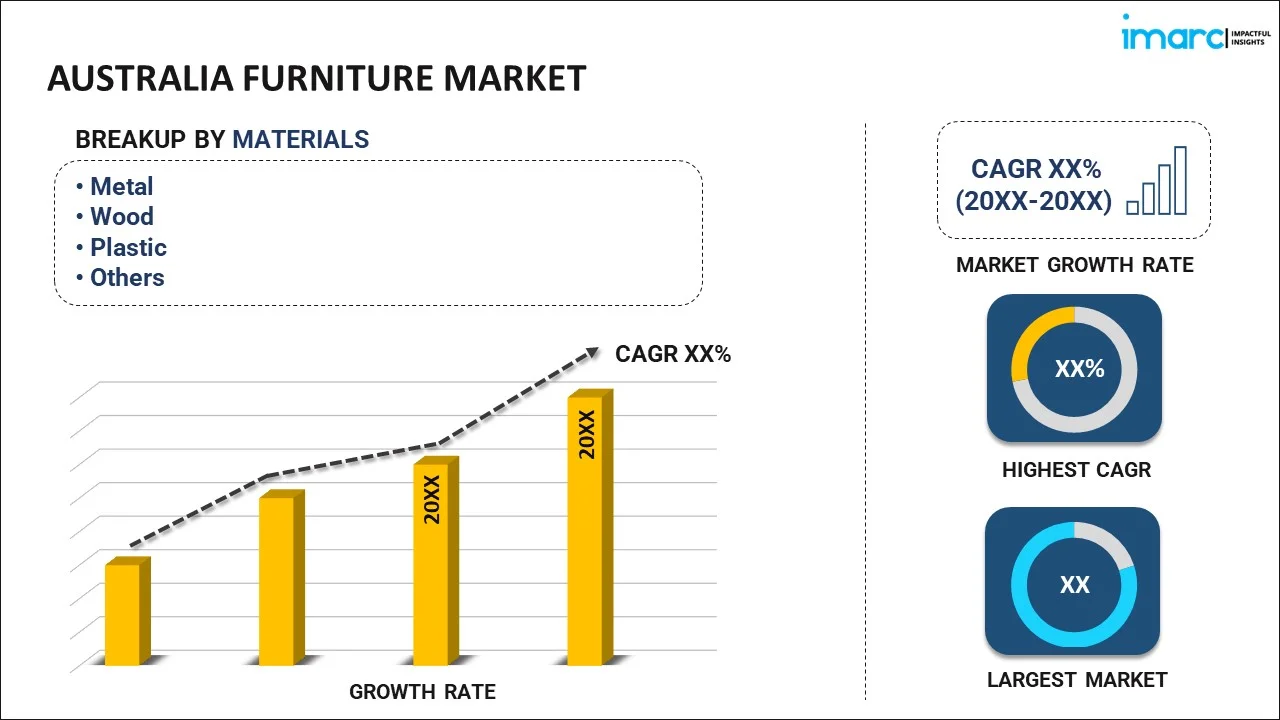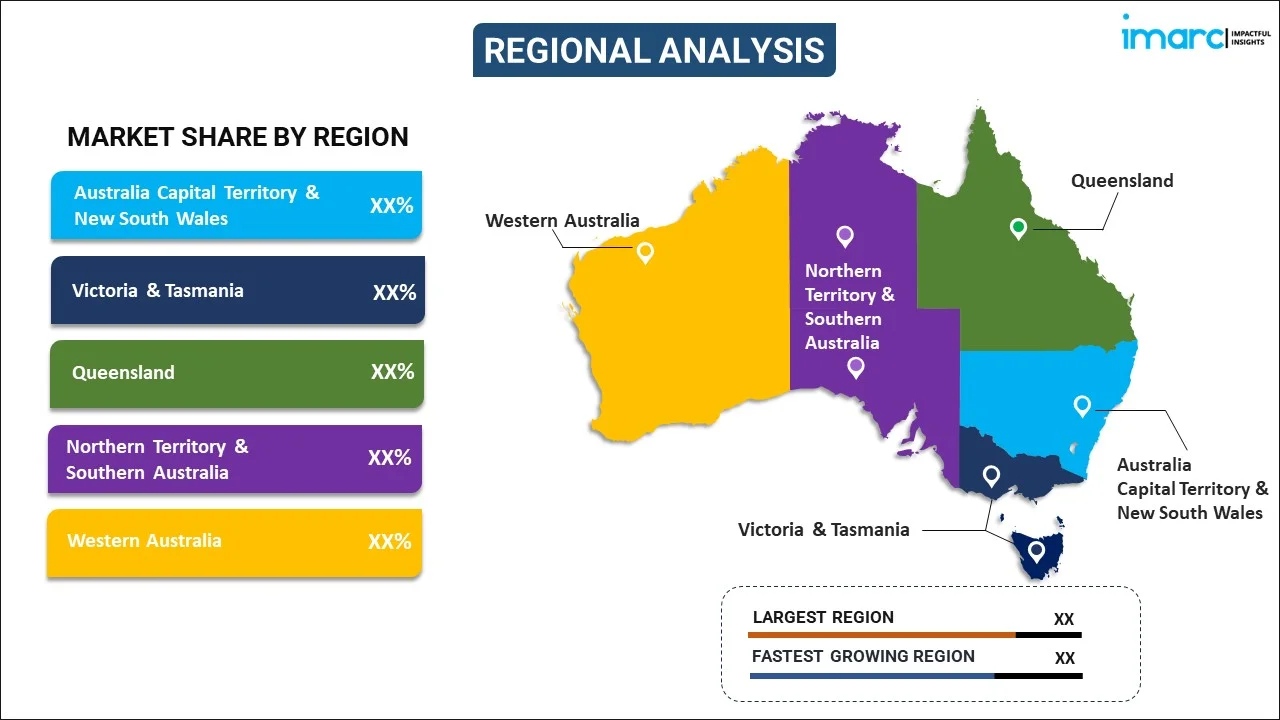
Australia Furniture Market Report by Material (Metal, Wood, Plastic, Glass, and Others), Distribution Channel (Supermarkets and Hypermarkets, Specialty Stores, Online Stores, and Others), End Use (Residential, Commercial), and Region 2025-2033
Market Overview:
Australia furniture market size is projected to exhibit a growth rate (CAGR) of 5.8% during 2025-2033. The growing focus of key manufacturers and suppliers on using friendly packaging and transportation practices is primarily augmenting the market growth across the country.
|
Report Attribute
|
Key Statistics
|
|---|---|
|
Base Year
|
2024 |
|
Forecast Years
|
2025-2033
|
|
Historical Years
|
2019-2024
|
| Market Growth Rate (2025-2033) | 5.8% |
Furniture comprises movable items created to facilitate various human activities, such as sitting, sleeping, storing possessions, etc. This category includes diverse pieces like chairs, tables, beds, cabinets, etc., typically crafted from materials, such as wood, metal, plastic, upholstery, etc. Its primary function is to offer comfort, enabling individuals to relax and engage in activities with ease. Beyond functionality, furniture contributes to the visual appeal of a space, enhancing the aesthetics and creating a pleasing atmosphere. Commonly found in households, furniture is utilized in various rooms, including living rooms, bedrooms, kitchens, dining areas, etc., serving as essential elements for both practical and decorative purposes.
Australia Furniture Market Trends:
The Australia furniture market is experiencing significant growth, propelled by a confluence of key factors. Firstly, evolving lifestyle trends and changing consumer preferences are driving the demand for innovative and stylish furniture pieces. Individuals across the country are seeking functionality and aesthetics, as they invest in pieces that reflect their unique tastes. Moreover, the impact of e-commerce on the retail landscape significantly influences the Australia furniture market. Besides this, the convenience of online shopping, coupled with a wide variety of choices and competitive pricing, resonates with consumers, fostering a surge in digital transactions within the furniture sector. Additionally, sustainability considerations play a pivotal role in shaping the market dynamics. Apart from this, individuals are increasingly inclined towards eco-friendly and responsibly sourced furniture, thereby reflecting a broader shift towards sustainable living. Furthermore, leading manufacturers are responding to this trend by adopting eco-conscious practices and materials, which is also stimulating the market growth. In addition to this, the rising integration of advanced technologies in furniture design, such as smart and multifunctional pieces, is a noteworthy driver. Consumers are drawn to furniture that aligns with their tech-savvy lifestyles, leading to an increased demand for innovative and connected furnishings. This, in turn, is expected to fuel the Australia furniture market over the forecasted period.
Australia Furniture Market Segmentation:
IMARC Group provides an analysis of the key trends in each segment of the market, along with forecasts at the country level for 2025-2033. Our report has categorized the market based on material, distribution channel, and end use.
Material Insights:

- Metal
- Wood
- Plastic
- Glass
- Others
The report has provided a detailed breakup and analysis of the market based on the material. This includes metal, wood, plastic, glass, and others.
Distribution Channel Insights:
- Supermarkets and Hypermarkets
- Specialty Stores
- Online Stores
- Others
A detailed breakup and analysis of the market based on the distribution channel have also been provided in the report. This includes supermarkets and hypermarkets, specialty stores, online stores, and others.
End Use Insights:
- Residential
- Commercial
The report has provided a detailed breakup and analysis of the market based on the end use. This includes residential and commercial.
Regional Insights:

- Australia Capital Territory & New South Wales
- Victoria & Tasmania
- Queensland
- Northern Territory & Southern Australia
- Western Australia
The report has also provided a comprehensive analysis of all the major regional markets, which include Australia Capital Territory & New South Wales, Victoria & Tasmania, Queensland, Northern Territory & Southern Australia, and Western Australia.
Competitive Landscape:
The market research report has also provided a comprehensive analysis of the competitive landscape. Competitive analysis such as market structure, key player positioning, top winning strategies, competitive dashboard, and company evaluation quadrant has been covered in the report. Also, detailed profiles of all major companies have been provided.
Australia Furniture Market Report Coverage:
| Report Features | Details |
|---|---|
| Base Year of the Analysis | 2024 |
| Historical Period | 2019-2024 |
| Forecast Period | 2025-2033 |
| Units | Million USD |
| Scope of the Report | Exploration of Historical Trends and Market Outlook, Industry Catalysts and Challenges, Segment-Wise Historical and Future Market Assessment:
|
| Materials Covered | Metal, Wood, Plastic, Glass, Others |
| Distribution Channels Covered | Supermarkets and Hypermarkets, Specialty Stores, Online Stores, Others |
| End Uses Covered | Residential, Commercial |
| Regions Covered | Australia Capital Territory & New South Wales, Victoria & Tasmania, Queensland, Northern Territory & Southern Australia, Western Australia |
| Customization Scope | 10% Free Customization |
| Post-Sale Analyst Support | 10-12 Weeks |
| Delivery Format | PDF and Excel through Email (We can also provide the editable version of the report in PPT/Word format on special request) |
Key Questions Answered in This Report:
- How has the Australia furniture market performed so far and how will it perform in the coming years?
- What has been the impact of COVID-19 on the Australia furniture market?
- What is the breakup of the Australia furniture market on the basis of material?
- What is the breakup of the Australia furniture market on the basis of distribution channel?
- What is the breakup of the Australia furniture market on the basis of end use?
- What are the various stages in the value chain of the Australia furniture market?
- What are the key driving factors and challenges in the Australia furniture?
- What is the structure of the Australia furniture market and who are the key players?
- What is the degree of competition in the Australia furniture market?
Key Benefits for Stakeholders:
- IMARC’s industry report offers a comprehensive quantitative analysis of various market segments, historical and current market trends, market forecasts, and dynamics of the Australia furniture market from 2019-2033.
- The research report provides the latest information on the market drivers, challenges, and opportunities in the Australia furniture market.
- Porter's five forces analysis assist stakeholders in assessing the impact of new entrants, competitive rivalry, supplier power, buyer power, and the threat of substitution. It helps stakeholders to analyze the level of competition within the Australia furniture industry and its attractiveness.
- Competitive landscape allows stakeholders to understand their competitive environment and provides an insight into the current positions of key players in the market.
Need more help?
- Speak to our experienced analysts for insights on the current market scenarios.
- Include additional segments and countries to customize the report as per your requirement.
- Gain an unparalleled competitive advantage in your domain by understanding how to utilize the report and positively impacting your operations and revenue.
- For further assistance, please connect with our analysts.
 Inquire Before Buying
Inquire Before Buying
 Speak to an Analyst
Speak to an Analyst
 Request Brochure
Request Brochure
 Request Customization
Request Customization




.webp)




.webp)












